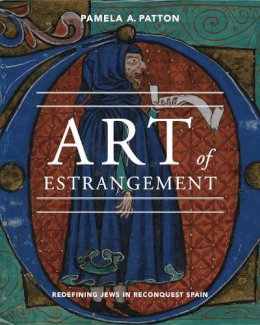17%OFF
Stock image for illustration purposes only - book cover, edition or condition may vary.
Art of Estrangement: Redefining Jews in Reconquest Spain
Pamela A. Patton
FREE Delivery in Ireland
Description for Art of Estrangement: Redefining Jews in Reconquest Spain
Hardback. .
At its peak in the twelfth and thirteenth centuries, the so-called Spanish Reconquest transformed the societies of the Iberian Peninsula at nearly every level. Among the most vivid signs of this change were the innovative images developed by Christians to depict the subjugated Muslims and Jews within their vastly expanded kingdoms. In Art of Estrangement, Pamela Patton traces the transformation of Iberia’s Jews in the visual culture of Spain’s Christian-ruled kingdoms as those rulers strove to affiliate with mainstream Europe and distance themselves from an uncomfortably multicultural past.
Art of Estrangement scrutinizes a wide range of works—from luxury manuscripts and cloister ... Read moresculptures to household ceramics and scribal doodles—to show how imported and local motifs were brought together to articulate and reinforce the efforts of Spain’s Christian communities to renegotiate their relationships with a vibrant Jewish minority. The arsenal of stereotypes, symbols, and narratives deployed to characterize Jews and their changing social roles often paralleled those found in contemporaneous literature and folklore; they ranged from such time-honored European formulae as the greedy usurer and the “Jewish nose” to locally resonant conflations of Jews with Muslims. The book’s close, contextualized reading of works from the late twelfth through early fourteenth centuries draws on recent scholarship in Iberian history, religion, and cultural studies, shedding new light on the delicate processes by which communal and religious identities were negotiated in medieval Spain.
Show Less
Product Details
Publisher
Pennsylvania State University Press
Place of Publication
University Park, United States
Shipping Time
Usually ships in 7 to 11 working days
About Pamela A. Patton
Pamela A. Patton is Director of The Index of Medieval Art at Princeton University.
Reviews for Art of Estrangement: Redefining Jews in Reconquest Spain
“Few scholars can demonstrate facility with visual culture across such a wide geographical and cultural arena, much less articulate it with insight, vigor, and clarity. Pamela Patton's Art of Estrangement will be a significant contribution to the growing art-historical literature on medieval Christian representations of non-Christians, and, more generally, it will push ahead our understanding of how works of art ... Read morefunction as active agents in the formation of cultural attitudes.” —Debra Higgs Strickland, University of Glasgow “Art of Estrangement is a masterful study of the meaning of images of Jews in Iberian Christian visual culture after the Reconquista. The incisive analysis Pamela Patton offers of these intriguing and sometimes disturbing images is most welcome—and, in fact, revolutionary.” —Marc Michael Epstein, Vassar College “Broad in scope yet authoritative and rich in detail, Patton’s study will for a long time provide an entry point into the visual culture of medieval Spain for students, scholars, and anyone interested in Christian-Jewish relations. . . . It is precisely its combination of range, rigor, and wonderful images that makes the Art of Estrangement so impressive and so important.” —Tom Nickson Studies in Christian-Jewish Relations “Lucidly argued, elegantly written, beautifully illustrated, and covering much needed scholarly territory, The Art of Estrangement was a pleasure to read and will be a required text from now on in my ‘Three Cultures of Spain’ course.” —D. Fairchild Ruggles Review of Metaphysics “Scholars interested in putting disciplines into conversation with one another will find this book to be a helpful and thought-provoking model. With sumptuously reproduced color plates and a clear, accessible discussion of Jewish iconography, Art of Estrangement will also be a welcome addition to undergraduate and graduate courses in both Jewish and medieval studies.” —Jonathan Ray AJS Review “Art of Estrangement: Redefining Jews in Reconquest Spain makes major strides toward our understanding of how visual images of Jews were developed and understood in Medieval Spain. It is an ambitious undertaking, showcasing difficult material and opening new lines of inquiry.” —Julie Harris Medieval Encounters “Art of Estrangement is an important contribution to evolving research on the yet untapped potential of visual culture to help expand and refine our knowledge gained from textual sources.” —Zsofia Buda Jewish History “Pamela A. Patton’s Art of Estrangement: Redefining Jews in Reconquest Spain makes an important contribution to the already rich field of medieval art and Jewish-Christian relations. Scholars such as Bernhard Blumenkranz, Michael Camille, Ruth Mellinkoff, Heinz Schreckenberg, Sara Lipton, Debra Higgs Strickland, Mitchell Merback, Vivian Mann, Nina Rowe, Herbert Kessler, and David Nirenberg, among others, have examined the ways in which Christian art expresses perceptions of Jews and Judaism. As Patton points out, these studies focus primarily on northern European art. Patton expands the scope of this current scholarship by demonstrating that Iberian Christian imagery incorporated, altered, or resisted northern European visual representations of Jews in order to express and shape its unique historical circumstances: the Christian conquest of Muslim-controlled territories in Spain that had significant Jewish populations between the late twelfth century and mid-fourteenth century. Throughout the book, an abundance of beautifully reproduced images invites the reader to closely observe visual details that support Patton’s analysis.” —Sarah Bromberg caa.reviews “A tour de force of analytical historiography, offering scholars of medieval Iberia and medieval Jewish– Christian relations more generally a wealth of examples, a sharp and original interpretive frame, and a fine model to follow in realizing future work on medieval inter-religious contact and conflict.” —Ryan Szpiech Revista Hispanica Moderna Show Less


